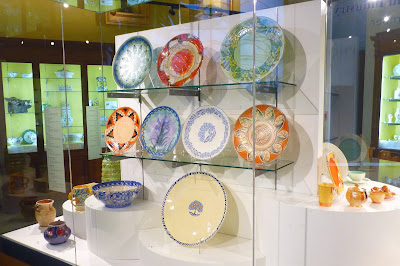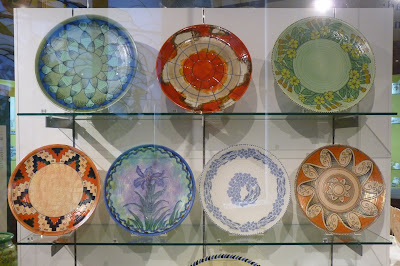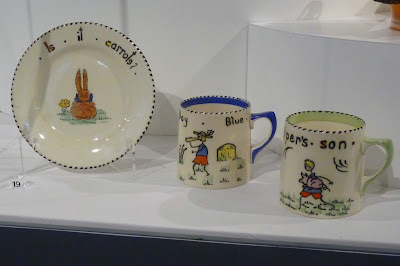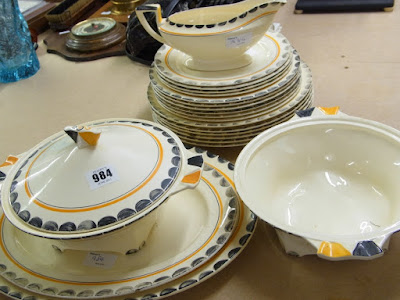Collectors of Charlotte's tube-lined designs from Crown Ducal may have noticed items where the tube-liner has added numbers, letters or marks other than a Rhead signature or tube-liner identifying mark to the base.
These fall into five categories:
- Production instructions - tube-lined .K. and .S. marks (and similar)
- Tube-lined shape numbers
- Tube-lined pattern numbers
- Triangles of 3 tube-lined dots
- And others!
All of these markings must have had a purpose at the time they were applied. Sometimes the purpose is clear such as the pattern number, but it may not be evident why the pattern number was tube-lined on some items and not others. This post is a summary of my thoughts so far on what can be read into these "additional" markings.
The tube-lined .K. mark
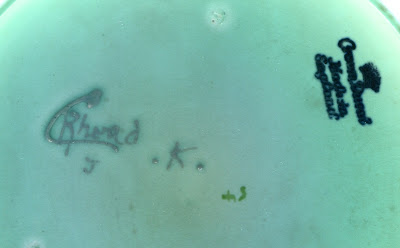 |
| Tube-lined .K. mark on a Persino pattern 3052 12" charger |
Occasionally you may come across a tube-lined letter K with a dot either side, “.K.” on the base. The mark is obviously applied by the tube-lining artist at the time she signed her Rhead signature. There is evidence that it is a message to the enamellers, gilders and lustrers that the pot need to be decorated in a different way to usual. Bernard Bumpus records the K mark as a possible identifier for a tube-liner, but this would not make sense because it is usually accompanied by a known tube-liners mark and therefore must have another purpose.
The single mention of the “.K.” mark in the Crown Ducal pattern books is under the entry for the Green Chain pattern 4298 where there is a pencil notation, “To be marked .K.” I have recorded 7 examples from the original production run of pattern 4298, (AGR2 backstamp style), that have the “.K.” mark. The only other patterns seen to date with the “.K.” mark are Byzantine 2681, (24 examples) and Persino 3052, (13 examples) which are different colourways of the same design.
The possibility that the mark might be to alert the decorators to apply different colours is reasonable because in 1935 both orange and green versions of the Chain pattern, (4100 and 4298), would have been in production. The tube-lining was exactly the same for the two patterns, so instructions would have to be passed somehow as to what colours should be used to fulfil the required client orders.
Unfortunately the theory breaks down because, of the Byzantine/Persino pairing of “.K.” marked pieces the 25 Byzantine pots are decorated in traditional 2681 colours, not 3052 colours. Therefore if the mark was an instruction to the enamellers then the message was ignored most of the time!
This could be resolved by changing the the meaning of the ".K." mark to - ask the supervisor what colours to decorate the pot with because two versions are in production at present - that might work.
Whatever the precise meaning, the general idea still has merit because further study of the pattern books reveal that two other patterns have instructions that they should be marked in a specified manner. These are 4300 and 4318, which are variations of the Tudor Rose pattern. For pattern 4300, the instruction is “To be marked ".B.”, which makes sense as one of the dominant colours in the design is blue. Similarly for pattern 4318 the instruction is “To be marked .O.”, where the dominant colour is orange. It should be said that at the time of writing no examples of Tudor Rose have been seen with a tubelined “.B.” or “.O.”. Please let me know if you have one.
The tube-lined .S. mark
 |
| Tube-lined S mark on a Lotus Leaves pattern 2682 bowl |
The “.S.” mark is more problematic, it can exist with or without the dot marks either side, there is no reference to it in the pattern books and it occurs on a wider range of patterns, sometimes with only a few observations, or a single example. Of the 38 examples seen it is most commonly found on the Lotus Leaves pattern, (2682), Rhodian, (3272) and Trellis, (6016). But also examples are known on patterns 2691, 2801, 3797, 4016, 4040, 5391, 5393, 5802, 5803, 6017 and rare unnumbered trial designs.
Some of these patterns exist in different colourways. For Lotus Leaves most of the ".S." marked items are the rarer green wash variation , (but not exclusively). Several other designs in the list above exist in different colourways, either with the same pattern number or a different one. There is a high proportion of variations to the true designs amongst the ".S." marked items but equally, in many cases it does not appear that the decorators modified the enamelling in any way.
First thoughts are that the ".S." represents an instruction for special colouring since the two colourways of Lotus Leaves are the earliest known colour variation of Charlotte’s Crown Ducal patterns. A single jug in the Turin, (2691) pattern without any enamels has been seen with an S mark.
The next occurrences of S are on Rhodian, (3272), but only one of the five examples has any variation of the design and that is in the green and blue colourway. After that, examples are scarce until the 5391 special blue/mauve mottle glaze pots, (also used for Iris & Floretta patterns). Then two examples on Fruit Border, (5802), only one of which appears different to type with a border motif more akin to Rhodian. There is one example on Palermo, (5803), which is a special variation of the design, (or the original prototype) with two rows of petals, and several on Trellis, (6016), none of which appear to exhibit any variation from type.
The evidence is not very compelling, the suggestion that these marks were originally devised as codes for alternative colour decoration remains a possibility. Or perhaps the mark meant they were the "Samples" for the Crown Ducal travellers, (sales representatives) to take for showing to clients - but then the range of items seen would seem rather odd with several 2682, 3272 and 6016 but none or very few of the other patterns. It is also worth remembering that "Special" or "Sample" may not relate just to the pattern or a variation in the pattern, but could be about the shape. A handled vase in shape 198 exists in pattern 2801 with an ".S." mark and the AGR2 backstamp. It appears to be the standard Byzantine/Danube design, but this would not have been a new design when it was made. But the shape was new, it only went into production at the beginning of 1935, and so the "Sample" may have been to show off the new shape rather than the pattern itself.
It is probably best just to say it might mean that the pot is destined for a special purpose so that it might be decorated with extra care and be identified, retrieved and set aside at the end of the decorating process for whatever this special purpose might be.
Just to add to all the uncertainty in these matters, one item, (a smokers box in Stitch , 3274) is marked "SS" and a green washed Lotus Leaves jug with green wash is marked "SD". "Special Shape" and "Special Design" - who knows?
Tube-lined shape numbers
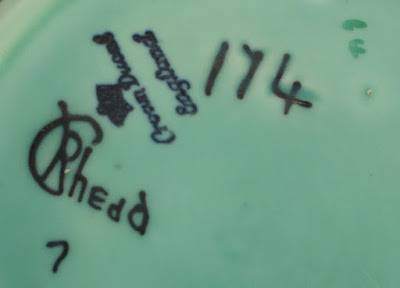 |
| Tube-lined shape number 174 on a Primula pattern bowl |
The shape number of is often tube-lined on the base of vases and some bowls, but this practice appears to have ceased sometime during 1936. It is not uncommon to find the early patterns and examples of Persian Rose, (4040), or Green Chain, (4298), with the feature but much less so on Tudor Rose, (4491) or Manchu, (4511). No design younger than Manchu has been observed with a shape number tube-lined on the base.
The new shapes that were introduced in 1936 like 209, 211, 212, 213 and 214 all had the shape number moulded within a recessed rectangle quite clearly in the base so that the glaze could not obscure the figures as was often the case with the inscribed shape numbers. It was probably at about this time that it was deemed unnecessary to tube-line the number as well.
This is quite a useful date marker but not a very precise one. Although the new shapes with moulded numbers are almost certainly the trigger to stop tube-lining shape numbers, it is impossible to say if the practice stopped because of a change in policy or it gradually ceased because it was becoming a wasted effort. My thoughts lean to the former scenario because I have only seen one pot from those shape numbers, 209-214, with a tube-lined shape number and that is a shape 209 with pattern 2801. A splendid vase produced late in the production period for the Danube pattern and may possibly have been a special order or one of the first trial pieces to show off the the new large vase shape 209.
Tube-lined pattern numbers
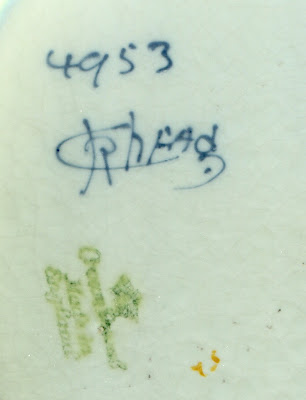 |
| Tube-lined pattern number 4953 on a Foxglove 12" charger |
If shape numbers stopped being tube-lined in 1936 is is almost the opposite story for pattern numbers. In the early 1930s it appears that only slip decorated patterns had tube-lined pattern numbers. These would be the big salad bowls and platters for the USA market and the Blossom design on snow glaze, pattern 4538. If a pattern number is present on any other design it would have been applied by the enameller or lusterer.
Then sometime, in 1936, it becomes more likely that the pattern number is tube-lined for all designs. Certainly observations show that patterns 4921, 4922, 4924, 4926, 4953 and 4954 have a very high chance of having tube-lined pattern numbers. These would all have been promoted strongly at the British Industries Fair in March 1937 so perhaps it was decided with the great surge in orders that it was more efficient for the tube-liners to number the pots rather than the paintresses.
Triangles of 3 tube-lined dots
 |
| Tube-lined 3 dot triangle mark on a Stitch pattern 3274 bowl |
These are a fascinating curiosity. I have details of 16 items where there is a small triangle of 3 tube-lined dots on the base, 8 are on Byzantine, 2681, 1 on Lotus Leaves, 2682 and the remaining 7 on Stitch, 3274. The Byzantine and Lotus Leaves pots all have Charlotte's own signature on the base. So can we presume that the triangle of dots mean these pots are the work of Charlotte Rhead, and consequently that Charlotte even mucked in with tube-lining examples of the simple Stitch pattern herself? I believe there has to be a more involved explanation than that otherwise why sign and add the dots as well.
And Others!
A couple of other marks have been seen. A single example of a tube-lined asterisk and two examples of the the letters ".N.M.". They do not appear to be decorated differently to type so there is not much point in speculating their meaning.



